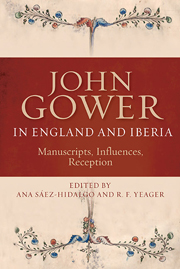Book contents
- Frontmatter
- Contents
- List of Illustrations
- Abbreviations
- Introduction
- I Manuscripts
- 1 Castilian Script in the Iberian Manuscripts of the Confessio Amantis
- 2 Provenance Interlacing in Spanish Royal Book-Collecting and the Case of the Confessio Amantis (RB MS II-3088)
- 3 Inglorious Glosses?
- 4 The Yale Gower Manuscript, Beinecke Osborn MS fa.1: Paleographical, Codicological, Technological Challenges and Opportunities
- II Iberia
- III The Classical Tradition
- IV Economy
- V Reception
- Notes on Contributors
- Bibliography
- Index
4 - The Yale Gower Manuscript, Beinecke Osborn MS fa.1: Paleographical, Codicological, Technological Challenges and Opportunities
from I - Manuscripts
Published online by Cambridge University Press: 05 August 2014
- Frontmatter
- Contents
- List of Illustrations
- Abbreviations
- Introduction
- I Manuscripts
- 1 Castilian Script in the Iberian Manuscripts of the Confessio Amantis
- 2 Provenance Interlacing in Spanish Royal Book-Collecting and the Case of the Confessio Amantis (RB MS II-3088)
- 3 Inglorious Glosses?
- 4 The Yale Gower Manuscript, Beinecke Osborn MS fa.1: Paleographical, Codicological, Technological Challenges and Opportunities
- II Iberia
- III The Classical Tradition
- IV Economy
- V Reception
- Notes on Contributors
- Bibliography
- Index
Summary
History of the manuscript
Early on in my career, in the late 1970s, Stephen Parks, then the Curator of the Osborn Collection in the Beinecke Rare Book and Manuscript Library, asked me to consider the possibility of cataloging the Osborn early manuscript collection. When I went to the library stacks and pulled out Osborn MS fa.1 (the official call number of the Gower manuscript under discussion) I was astounded by two things: first, the terrible smell that drifted my way upon removing the codex from its slip case, and second, the degree of what looked to be mildew damage that the parchment had experienced. Since this startling introduction to the manuscript, off and on, I have been intrigued with this codex and the various challenges it presents to scholars wishing to study it.
Stephen Parks quickly sent the volume off to the Cockerell studio in England to see if the mildew was still active; Sydney Cockerell kept the manuscript for two years, and in November 1979, wrote to Parks in a letter that is today in the Beinecke bibliographical files:
When the manuscript arrived here on December 31st, 1977, I drew round the mildew stains on verso 52 and recto 53 in pencil and there appears to be no change. The British Museum Research Laboratory had a look at the manuscript and the sample of the vellum from it that you sent to me and they were of the opinion that the staining was caused by mildew Dr. Lowring of the Biology Department of Cambridge University also had a look at a fragment and could not decide what the staining was caused by. He suggested that it might be chemical rather than a fungus and wanted to know the history of the manuscript.
- Type
- Chapter
- Information
- John Gower in England and IberiaManuscripts, Influences, Reception, pp. 77 - 86Publisher: Boydell & BrewerPrint publication year: 2014



